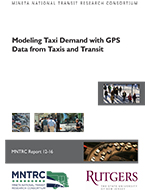Abstract:
Identifying factors that influence taxi demand is very important for understanding where and when people use taxis and how taxi demand relates to the availability and quality of transit service. This study used a large set of global positioning system (GPS) data from taxis in New York City, along with demographic, socioeconomic, and employment data to identify the factors that drive taxi demand. A technique was developed to measure and map transit accessibility based on the time required to access a transit vehicle from a specific location and time of day. Taxi data were categorized by pickups and drop-offs, and a hybrid cross-classification and regression model was developed to estimate the taxi demand across space and time. The study identified transit accessibility, population, age, education, income, and the number of jobs in each census tract as the factors with strongest explanatory power for predicting taxi demand. The study also includes a comparison of the cost of travel by taxi and transit for specific trips between Penn Station and each of the three major New York area airports. The model and analysis results show how the number of passengers traveling together in a group and the value they place on their time affect the likelihood of choosing taxi or transit for an airport access trip. A number of findings are presented in this report that are specific to New York City. However, the methods developed in this study and demonstrated in this report can be applied generally to cities around the United States and the world where similar GPS data from taxis and schedule information from transit are available.
Authors:
ERIC GONZALES PH.D.
Dr. Eric Gonzales is currently an Assistant Professor in the Department of Civil and Environmental Engineering at the University of Massachusetts Amherst, and previously he was an Assistant Professor at Rutgers University. His research interests are in the operation, management, and design of multimodal transportation systems. He has experience in macroscopic modeling of urban street networks and developing models and theory for how to allocate scarce street space to multiple transportation modes. He also has expertise in the planning and management of public transportation systems, including demand responsive systems. Dr. Gonzales received a Ph.D. in Civil and Environmental Engineering at UC Berkeley in 2011. He received recognition as the University of California Transportation Center’s Outstanding Student of the Year for 2010-2011 and as an Eno Transportation Foundation Fellow in 2010.
CI (JESSIE) YANG, M.S.
Ci (Jessie) Yang works as a Graduate Assistant in Civil and Environmental Engineering at Rutgers University, specializing in transportation. She received her Master of Science in Environmental Engineering from Texas A & M University, Kingsville, and Bachelor of Science in Environmental Science from People’s University of China. Ms. Yang is currently working with GPS data from taxis in New York City in order to study travel demand and mode choice. Ms. Yang plans to become a transportation researcher to help design an intelligent, efficient, and sustainable transportation system worldwide.
ENDER FARUK MORGUL, M.S.
Ender F. Morgul works as a Graduate Research Assistant at the Civil and Urban Engineering Department in Polytechnic Institute of New York University. He received his B.S. from Bogazici University and M.Sc. in Civil Engineering from Rutgers University. His research interests include modeling and prediction of driver behavior, transportation economics, urban freight operations, big data and GPS-based transportation data analysis. His 2010 M.Sc. thesis investigated dynamic congestion pricing using large-scale traffic simulations..
KAAN OZBAY, PH.D.
Kaan M.A. Ozbay is Professor at the Department of Civil and Urban Engineering at NYU-Poly and Center for Urban Science and Progress (CUSP). Dr. Ozbay’s research interest in transportation covers advanced technology and sensor applications; incident and emergency management; development of real-time control techniques for traffic, traffic safety, application of artificial intelligence, and operations research techniques in network optimization; development of simulation models for transit and automated highway systems; and transportation economics. He is co-editor of numerous books, including, most recently, Dynamic Traffic Control & Guidance published by Springer Verlag’s “Complex Social, Economic and Engineered Networks” series published in 2013. He has published more than 300 refereed papers in scholarly journals and conference proceedings. Prior to NYU, he was a tenured full professor at the Rutgers University Department of Civil and Environmental Engineering. Since 1994, Dr. Ozbay, has been the Principal Investigator and Co-Principal Investigator of 77 projects funded at a level of more than $11,00,000 by National Science Foundation, NJDOT, NYMTC, NY State DOT, New Jersey Highway Authority, USDOT, FHWA, VDOT, CUNY University Transportation Research Center (UTRC), Department of Homeland Security, and USDOT ITS Research Center of Excellence.


